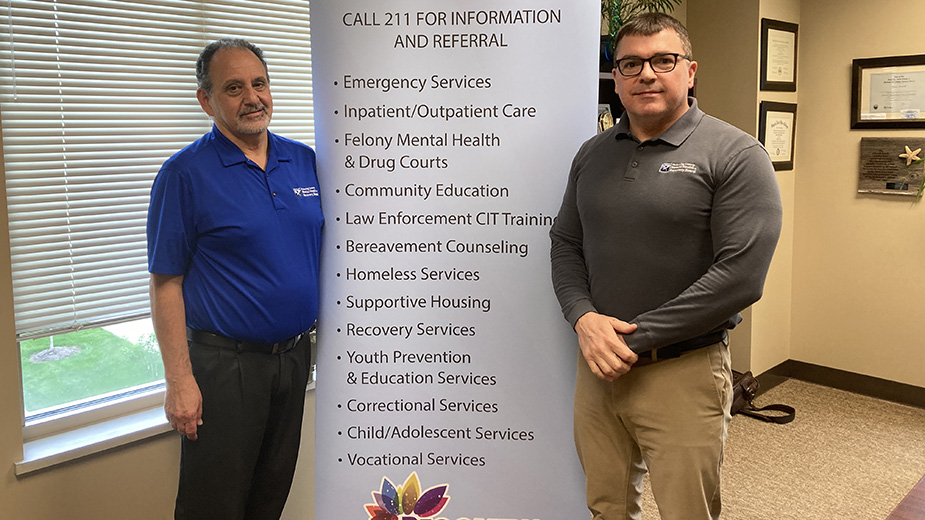YOUNGSTOWN, Ohio – As suicide rates rise, particularly among older white men, the Mahoning County Mental Health and Recovery Board is calling on employers and other gatekeepers to question, persuade and refer.
“We’re having more suicides than ever,” says Duane Piccirilli, executive director of the Mahoning County Mental Health and Recovery Board. “It’s spiking.”
The numbers are increasing for white men over 60, too, he says.
May is Mental Health Awareness Month. People who are considering suicide or who are experiencing a similar crisis should call or text 988, the Suicide & Crisis lifeline or chat at 988lifeline.org.
The county mental health board is offering free QPR – Question Persuade Refer – training. The training through the QPR Institute educates people to question individuals about suicide, persuade them to get help and refer them to the appropriate resource.
“We’re hoping businesses will take the 90 minutes and train their staff,” he says.
To schedule a training or to get more information, employers may contact the Coalition for Drug-Free Mahoning County at 330-771-7732.

“With this, they have the right questions to ask and to persuade … and where to refer, which would be 988,” Piccirilli says.
Mercer County, Pa., also offers QPR training, says Anna Shears, program analyst for the Mercer County Behavioral Health Commission and chairwoman of the Mercer County Suicide Prevention Network. That network involves several organizations.
“There are many agencies involved,” Shears says. “We partner with as many people and organizations as we can. We have representatives from schools, colleges in the area, local inpatient units, crisis units, outpatient mental health clinics, churches, the VA. We have many partners and we’re always looking to have more partners.”
The Numbers
In the first quarter of this year, 14 people in Mahoning County committed suicide. Last year, 53 people died by suicide. It was 44 in 2022 and 41 in 2021.
The number of men who commit suicide is traditionally higher than the number of women. But the number of older white men who commit suicide is rising.
“We’ve doubled from where we were last year,” says Lee DeVita, program coordinator at the Mahoning County MHRB.
In the first quarter, 10 men committed suicide and four of them were at least 60. In 2023, 46 men killed themselves and 16 were 60 or older. The numbers that year also included two women older than 80.
In 2022, 37 men committed suicide and 11 of them were at least 60. Of the 34 men who committed suicide in 2021, seven were 60 or older. In all years, most of them are White.
Across Ohio, people 34 to 65 comprise the largest segment who commit suicide.
In Mercer County last year, 10 people committed suicide. That was up from nine the previous year. In 2021, there were 11.
Shears says the number of older white men has increased, “but I can’t say it spiked.” Last year, six people – men and women – ages 55 to 64 committed suicide. “That’s on the higher end,” she says.
The director of clinical services at the Trumbull County Mental Health and Recovery Board, Katie Cretella, says that nationally, the number of middle-aged white men who commit suicide historically has been higher.
Last year in Trumbull, 32 people committed suicide of whom 23 were men. Of the suicide total, 12 were 55 or older and two were at least 75.
For 2022 in Trumbull County, 26 people committed suicide; 20 were men and 14 were 55 or older. In 2021, the total was 16 and 11 of them were at least 55; 13 were men.
In Columbiana County, the number of suicides was 11 in both 2023 and 2022, down from 22 in 2021.
The executive director of the Columbiana County Mental Health and Recovery Board, Marcy Patton, says there’s been an uptick the last few years in the number of older White men who commit suicide. Most involve firearms.
How It’s Being Addressed
Patton says Columbiana County has gunlock distributions as one initiative. It also promotes 988. Even with state and national campaigns and with the many athletes and celebrities talking about the importance of mental health, she says, many men won’t seek treatment.

That may be even more so in a rural community where men grow up believing they need to be the strong ones and take care of their own.
Columbiana County is promoting a state campaign called Man Therapy that relies on humor. The website, ManTherapy.org, lists topics with videos and resources where visitors may seek help and information. The board also started outreach at high school football games. They pass out 988 cards and have moments of silence and information in the announcements to share knowledge in a nonthreatening way.
The Mahoning County Mental Health & Recovery Board has formed a coalition with Direction Home, formerly the Area Agency on Aging, and Mahoning County Public Health to address the rising suicide rates.
“The big thing with this is mental health care is health care,” Piccirilli says.
The board is trying to determine what is causing the increase.
“We have a suicide fatality review committee that meets,” DeVita says, and it includes MCMHRB, the Mahoning County sheriff’s department, health district and coroner’s office. “We meet to kind of identify if there’s trends and things that are going on that we can pinpoint and use for the prevention end of it.”
Members meet quarterly to review coroner’s reports and other information to detect trends.
“One of the things we learned years ago is that most people go to their primary care physicians about six weeks before they attempt suicide,” Piccirilli says. “That has made the medical community across the country start to do depression screenings.”
Women will go in and say they’re depressed,” he says. “Men will go in with ailments.”
Mahoning County and its juvenile court worked together to establish it as a trauma-informed community.
“One of the golden rules of trauma-informed care is you ask what’s happened to them, not what’s wrong with them,” Piccirilli says.
In 2023, 12 people 70 or older committed suicide in Mahoning County. DeVita calls that alarming.
“Some of it is chronic health issues, issues with dementia or Alzheimer’s. Maybe some of them it’s money issues or loss of a spouse or loved one,” DeVita says. “They just feel like they’re no longer needed or they don’t have a sense of purpose.”

Cretella says Trumbull uses multiple campaigns to address suicide. To address an increase a few years ago in youth suicide, the recovery board launched a contest for young people to create public service announcements. The first year, promotion of 988 was a requirement for entries.
The Trumbull board also promotes 988, distributing items like pens, cards and brochures with the information. In a recent campaign, the board worked with area coffee shops to have information directing people to its website on coffee sleeves.
To address suicide among Black males, the board worked with barber shops, providing capes and mirror clings with the message, “Life is Better with You In it.”
In Mercer, the prevention network began an initiative last year to work with food banks and with agencies that deliver food to older people. They include postcards with the food boxes, providing a number for people to call if they’re feeling depressed or lonely.
Some Signs
Nationally, more women attempt suicide. But more men succeed, the mental health professionals say. Men tend to use more lethal means. But every attempt must be taken seriously, Piccirilli says.
People should watch for warning signs: personality changes, giving away prized possessions, talking about death and making it seem normal.
Someone talking about how he won’t always be here is a sign. “People shouldn’t be dwelling on death,” Piccirilli says.
If that’s happening, a loved one or an employer should have a frank conversation with the individual and ask if he’s thinking of harming himself. It’s OK to have that conversation, DeVita and Piccirilli say. If the person is acting on plans for self harm, 911 should be called.
The pandemic created the perfect storm for depression, the MCMHRB says. People in support groups were limited to online versions if anything at all. People were isolated and experiencing anxiety.
“They say if you see something, say something,” he says. “This is that kind of thing.”
Although the statistics report a higher incidence of suicide among older White men, people should be watchful of employees or loved ones regardless of demographics.
“Suicide can be contagious,” Piccirilli says. If someone hears about suicide or knows someone who has done it, they may decide to follow.
By partnering with Direction Home, the recovery board hopes to reach retired people who need help.
The recovery board recently earned a grant from the Ohio Suicide Prevention Foundation to train two individuals for survivors of suicide loss groups.
The statistics also include suicide by veterans. They may be triggered by scenes of wars across the globe that they see on television, the mental health professionals say.
This month, a speaker will talk about the QPR training for first responders. The session is offered through the Ohio Suicide Prevention Foundation.
Law enforcement officers and firefighters also experiences high suicide rates. From 2017 through 2022, 53 of Ohio’s first responders died by suicide, according to the Ohio Department of Public Safety. Nationally, 1,242 first responders died by suicide. And the numbers are believed to be underreported for that of first responders.
“This is too big of a problem for us to deal with ourselves,” Piccirilli says. “I think everybody has to be gatekeepers.”
Pictured at top: Duane Piccirilli and Lee DeVita of the Mahoning County Mental Health & Recovery Board talk about QPR.
